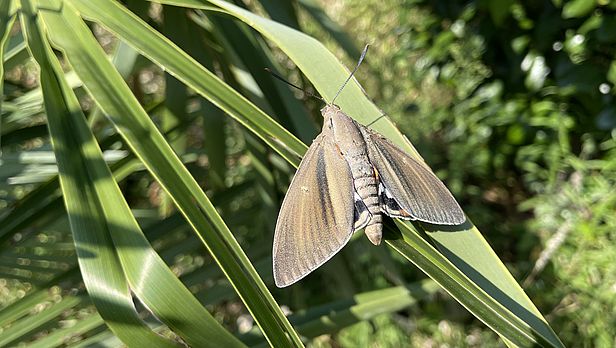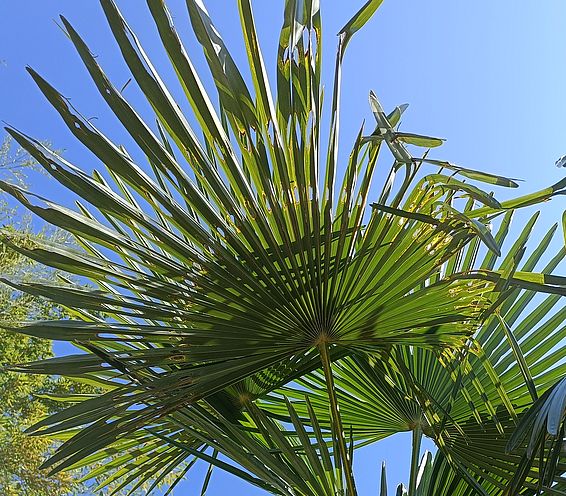09.10.2023 | WSL Cadenazzo ¦ Canton Ticino | WSL News
The palm moth, which is originally from South America, has been increasingly spotted in Southern Europe in recent years, where it poses a significant threat to palm trees as its larvae bore into the heart of palms, feeding on the inner tissues, weakening the plants, and potentially leading to their demise. In Southern Europe, various cultivated ornamental palm species are being attacked, as well as populations of the European fan palm (Chamaerops humilis), which is native to the Mediterranean and plays a vital role within its ecosystem. In summer 2023, the palm moth was recorded for the first time in the Canton of Ticino, southern Switzerland.

Aktuelle Situation (Sommer 2023) ¶
Sightings of the palm moth in Ticino have been confirmed in Brissago, Ronco sopra Ascona, and Lugano. The relatively high local infestation rate in Brissago suggests that the moth most likely arrived already some years ago but remained undetected. Introduction to the Canton of Ticino likely happened due to the introduction of infested ornamental palms and not by natural dispersion (flying moths) from neighbouring Italy. Among the affected palm species in these areas are the Chinese windmill palm (Trachycarpus fortunei), blue hesper palm (Brahea armata), European fan palm (C. humilis), and the Canary Island date palm (Phoenix canariensis). However, evidence from other regions suggest, that all palm species (with the exception of the dwarf palms of the genus Chamaedorea) that are climatically suited to Ticino, can be potential hosts of the palm moth.
What is there to do? ¶
This new occurrence of the palm moth raises questions about its potential impact in Ticino on ancient, cultivated palm specimens in gardens and public parks, as well as on the invasive Chinese windmill palm (T. fortunei) spreading in the peri-urban forests.
The current goal should focus on slowing the palm moth's spread to safeguard non-invasive ornamental palm species, while we anticipate the development of promising techniques and products for controlling the invasive palm moth.
In the present situation in the Canton of Ticino, the most promising control approach consists in removing the affected individuals. To this end, it is suggested that Chinese windmill palms be felled promptly from the first symptoms of the insect's presence, and possibly also ornamental palms that are heavily attacked. After the palm has been felled, the apical part of the trunk (approx. 60 cm of the palms’ top) must be separated from the leaves and sealed inside a tightly closed bag to prevent the escape of larvae or adult butterflies. All the material obtained must then be safely disposed of at the cantonal waste incinerator by contacting the facility in advance.
This is a simple measure, but one that should make it possible to safeguard non-invasive ornamental palm species for as long as possible. As for now, in Switzerland, alternative approaches like chemical or biological control products are either unavailable, prohibited, or have not demonstrated their effectiveness yet.
Finders of affected plants are kindly requested to report it to the email address of the Invasive Alien Organisms Working Group (OAI WG) dt-spaas.neobiota(at)ti.ch, providing information on the location of the finding (coordinates, map no. or address), the number of plants affected, and attaching photographs.
Detailed information ¶
Canton Ticino - Dipartimento del territorio ¶
Adrian Oncelli - Sezione forestale - Ufficio della selvicoltura e degli organismi pericolosi - tel. 091 814 28 50
Gisella Novi - Sezione della protezione dell’aria, dell’acqua e del suolo - Ufficio della gestione dei rischi ambientali e del suolo - tel. 091 814 29 04
Copyright ¶
WSL and SLF provide the artwork for imaging of press articles relating to this media release for free. Transferring and saving the images in image databases and saving of images by third parties is not allowed.




